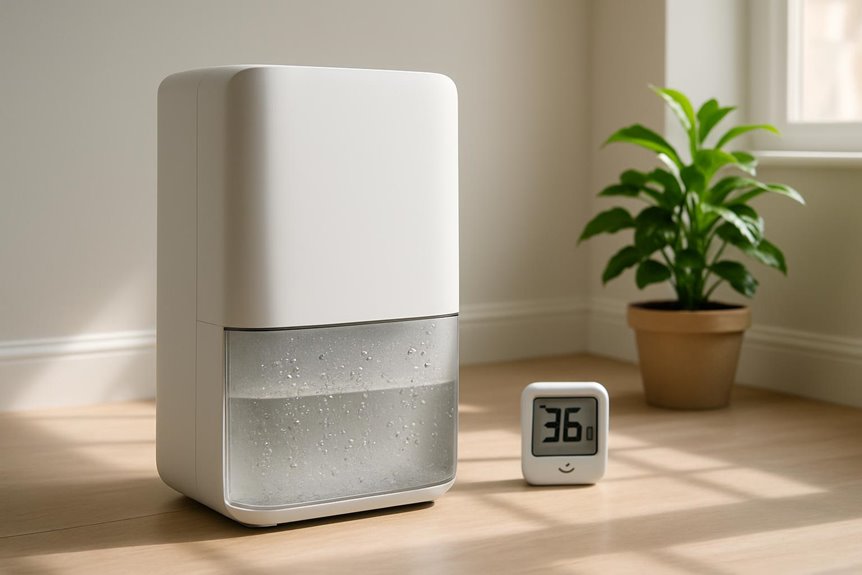When dealing with mold remediation, using dehumidifiers effectively is essential. It’s important to understand how capacity, airflow, and humidity monitoring play a role in the comprehensive process. Each of these factors notably impacts moisture removal and can influence the likelihood of mold returning. By focusing on these three key areas, property owners can create a healthier living environment. But what specific strategies can be implemented to maximize these benefits?
Key Takeaways
- Choose a dehumidifier with the right capacity, targeting about 30 pints per day for every 1,000 square feet affected.
- Optimize airflow by strategically placing fans to direct air towards damp areas and ensuring unobstructed vents for better moisture removal.
- Monitor humidity levels consistently using hygrometers to keep readings below 60% and prevent mold regrowth.
- Regularly assess the effectiveness of your dehumidifier and airflow strategy to enhance the mold removal process.
- Take proactive humidity control measures to create a healthier living environment and minimize future mold issues.
Choose the Right Dehumidifier Capacity
Choosing the right dehumidifier capacity is vital for effective mold remediation. Various dehumidifier types cater to different needs, making it important to understand which one suits a specific environment best.
The capacity calculation involves evaluating the square footage of the affected area and the humidity level; a general rule is that a unit should remove about 30 pints of moisture per day for every 1,000 square feet. For larger spaces or extreme dampness, higher-capacity models may be necessary.
Selecting an appropriate capacity not only enhances the dehumidifier’s efficiency but also accelerates the mold removal process, allowing individuals to reclaim their space and enjoy a healthier, more liberated living environment.
Optimize Airflow for Effective Moisture Removal
Effective moisture removal is greatly influenced by the optimization of airflow within the affected area. Proper airflow patterns can markedly enhance the dehumidification process, ensuring that moist air is efficiently circulated out.
Strategic fan placement can help direct airflow toward damp areas, facilitating quicker moisture removal. Positioning fans at various angles and heights allows for a more comprehensive coverage of the space, breaking up stagnant air pockets.
Additionally, ensuring that vents and openings are unobstructed promotes a smooth flow of air, further aiding in the reduction of humidity levels. By focusing on these elements, individuals can maximize the effectiveness of their dehumidifiers, leading to a successful mold remediation process and a healthier environment. Implementing these airflow strategies can also help reduce mold removal costs associated with professional services.
Monitoring humidity levels during the remediation process is crucial for evaluating the effectiveness of moisture control efforts. Utilizing various humidity measurement techniques guarantees accurate readings, providing insights into the environment’s conditions.
Homeowners and professionals alike can benefit from employing humidity monitoring devices, such as hygrometers and data loggers, to track changes over time. These tools allow for real-time assessments, helping to determine if the dehumidifiers are working effectively and if additional interventions are necessary.
Maintaining humidity levels below 60% can greatly reduce the risk of mold regrowth, creating a healthier living space. By consistently monitoring humidity, individuals can take proactive steps to safeguard their homes and achieve lasting results in mold remediation efforts.
Frequently Asked Questions
Running a dehumidifier for mold remediation typically requires continuous operation until ideal humidity levels, around 30-50%, are achieved. Adjusting dehumidifier settings throughout the process guarantees effective moisture control, fostering a healthier living environment.
Can I Use a Dehumidifier in a Finished Basement?
Using a dehumidifier in a finished basement is beneficial for moisture control. It helps reduce humidity levels, preventing mold growth and maintaining a comfortable environment. Regular use guarantees the space remains healthy and inviting for occupants.
What Maintenance Does a Dehumidifier Require During Mold Remediation?
During mold remediation, a dehumidifier requires regular maintenance, including filter cleaning and checking water collection. Ensuring these tasks are completed helps maintain ideal performance, ultimately supporting a healthier environment during the remediation process.
Is It Safe to Use a Dehumidifier Around Children and Pets?
Dehumidifier safety is generally high, but child precautions are essential. Keeping the unit out of reach and ensuring proper ventilation can create a safe environment. Always monitor usage to maintain comfort for both children and pets.
How Do I Know if My Dehumidifier Is Working Effectively?
To determine dehumidifier efficiency, monitor moisture levels using a hygrometer. Ideally, indoor humidity should be between 30-50%. If levels consistently fall within this range, the dehumidifier is functioning effectively and maintaining a comfortable environment.
Conclusion
To sum up, effectively using dehumidifiers during mold remediation is essential for a successful outcome. By selecting the appropriate capacity, optimizing airflow, and diligently monitoring humidity levels, you can create a healthier environment free from mold. Keeping humidity below 60% is key to preventing regrowth and ensuring long-term results. These simple yet effective strategies empower homeowners to tackle mold issues confidently, promoting a safer and more comfortable living space for everyone.

